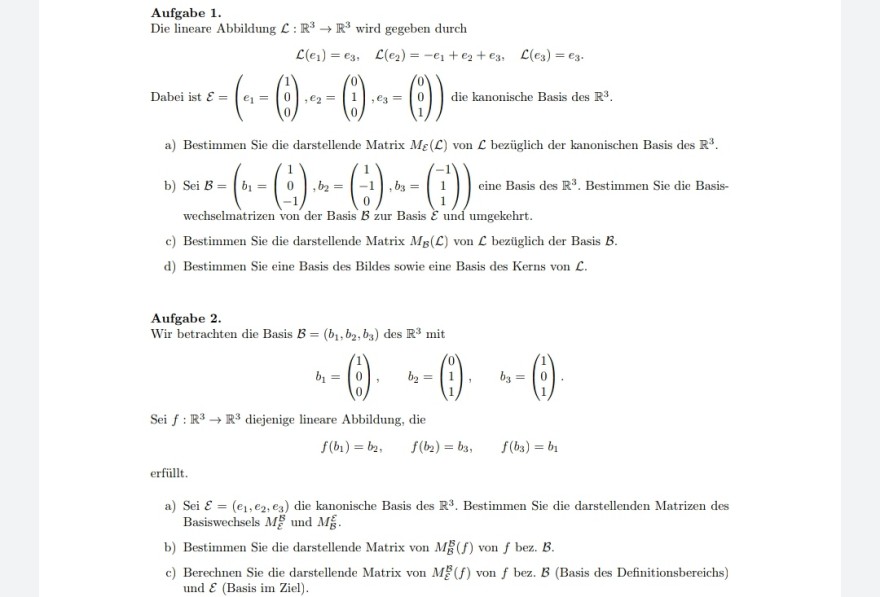
Text erkannt:
Aufgabe 1.
Die lineare Abbildung \( \mathcal{L}: \mathbb{R}^{3} \rightarrow \mathbb{R}^{3} \) wird gegeben durch
\( \mathcal{L}\left(e_{1}\right)=e_{3}, \quad \mathcal{L}\left(e_{2}\right)=-e_{1}+e_{2}+e_{3}, \quad \mathcal{L}\left(e_{3}\right)=e_{3} \)
Dabei ist \( \mathcal{E}=\left(e_{1}=\left(\begin{array}{l}1 \\ 0 \\ 0\end{array}\right), e_{2}=\left(\begin{array}{l}0 \\ 1 \\ 0\end{array}\right), e_{3}=\left(\begin{array}{l}0 \\ 0 \\ 1\end{array}\right)\right) \) die kanonische Basis des \( \mathbb{R}^{3} \).
a) Bestimmen Sie die darstellende Matrix \( M_{\mathcal{E}}(\mathcal{L}) \) von \( \mathcal{L} \) bezüglich der kanonischen Basis des \( \mathbb{R}^{3} \).
b) Sei \( \mathcal{B}=\left(b_{1}=\left(\begin{array}{c}1 \\ 0 \\ -1\end{array}\right), b_{2}=\left(\begin{array}{c}1 \\ -1 \\ 0\end{array}\right), b_{3}=\left(\begin{array}{c}-1 \\ 1 \\ 1\end{array}\right)\right) \) eine Basis des \( \mathbb{R}^{3} \). Bestimmen Sie die Basiswechselmatrizen von der Basis \( \mathcal{B} \) zur Basis \( \mathcal{E} \) und umgekehrt.
c) Bestimmen Sie die darstellende Matrix \( M_{\mathcal{B}}(\mathcal{L}) \) von \( \mathcal{L} \) bezüglich der Basis \( \mathcal{B} \).
d) Bestimmen Sie eine Basis des Bildes sowie eine Basis des Kerns von \( \mathcal{L} \).
Aufgabe 2 .
Wir betrachten die Basis \( \mathcal{B}=\left(b_{1}, b_{2}, b_{3}\right) \) des \( \mathbb{R}^{3} \) mit
\( b_{1}=\left(\begin{array}{l} 1 \\ 0 \\ 0 \end{array}\right), \quad b_{2}=\left(\begin{array}{l} 0 \\ 1 \\ 1 \end{array}\right), \quad b_{3}=\left(\begin{array}{l} 1 \\ 0 \\ 1 \end{array}\right) . \)
Sei \( f: \mathbb{R}^{3} \rightarrow \mathbb{R}^{3} \) diejenige lineare Abbildung, die
\( f\left(b_{1}\right)=b_{2}, \quad f\left(b_{2}\right)=b_{3}, \quad f\left(b_{3}\right)=b_{1} \)
erfüllt.
a) Sei \( \mathcal{E}=\left(e_{1}, e_{2}, e_{3}\right) \) die kanonische Basis des \( \mathbb{R}^{3} \). Bestimmen Sie die darstellenden Matrizen des Basiswechsels \( M_{\mathcal{E}}^{\mathcal{B}} \) und \( M_{\mathcal{B}}^{\mathcal{E}} \).
b) Bestimmen Sie die darstellende Matrix von \( M_{B}^{B}(f) \) von \( f \) bez. \( \mathcal{B} \).
c) Berechnen Sie die darstellende Matrix von \( M_{\mathcal{E}}^{\mathcal{B}}(f) \) von \( f \) bez. \( \mathcal{B} \) (Basis des Definitionsbereichs) und \( \mathcal{E} \) (Basis im Ziel).
Aufgabe: